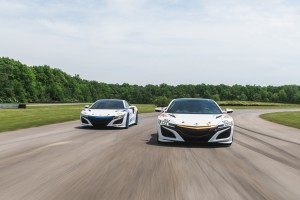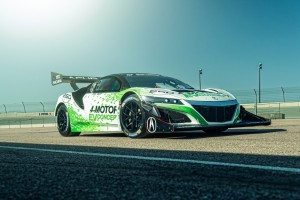Acura is eyeing a run up Pikes Peak when the annual hill climb commences in the coming weeks. And what better car to do so than the new NSX supercar? How about an Acura NSX prototype that adds a fourth motor and will run entirely on battery power?
In recent years, a number of battery-electric vehicles have plugged into the annual Pikes Peak International Hill Climb, including entries from Honda, Nissan and Mitsubishi. The new NSX is seen as a particularly promising entrant because of its advanced battery powertrain which uses its electric motors not only for propulsion but also to enhance steering.
“We’ve been tuning the car for several weeks at Pikes and have advanced its performance significantly,” said Tetsuya Yamano, who piloted last year’s Honda CR-Z prototype up the 14,114-foot tall mountain and who will now drive the NSX. “We’re honored to be running at Pikes in this historical, anniversary year – an event respected by racing fans all over the world.”
The stock Acura NSX is powered by a twin-turbocharged V-6 paired with three electric motors drawing power from a lithium-ion battery pack. The Sport Hybrid SH-AWD system – short for a hybrid-assisted version of the Acura Super-Handling All-Wheel-Drive system – uses one motor for each front wheel, with a third paired to the gas engine.
(Toyota, Acura hold highest five-year residual values. For more, Click Here.)
In corners, the speed of the front motors varies to provide an electric version of torque vectoring. The outer wheel runs faster than the one on the inside, helping steer through the turn.

Acura entered two other NSX cars, including one that is just about completely stock, in the Pikes Peak Climb.
The Acura NSX EV Concept will run in the Electric Modified Class. As the name suggests, the V-6 has been replaced with another electric motor, the prototype NSX now able to adjust torque at each wheel to further enhance handling. That’s no small feat considering that on the way to the summit, cars have to maneuver through a tiring 156 different turns.
(Click Here to see more about Acura’s plans to race the new NSX.)
Using an electric propulsion system has another advantage. At sea level, air pressure is about 14.5 pounds per square inch. At 14,114 feet, however, it will drop to about 8.5 PSI. That can mean a big difference when you’re trying to feed air into an internal combustion engine, straining even those with oversized turbo and superchargers.
Altitude has essentially no impact on the performance of a battery-car, however, one reason they have been clocking such good numbers in recent Pikes Peak runs.
(Check out TDB’s first drive in the new Acura NSX. Click Here for the story.)
That said, Acura will see other NSX supercars also challenge the hill in the Time Attack 1 and 2 classes. The former will have some modifications to its exhaust system, among other things, but the TA2 car will be almost entirely stock.

